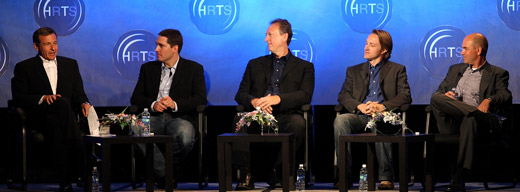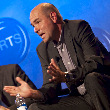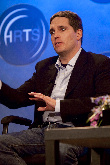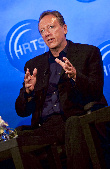|

From Philo T. Farnsworth’s invention of television in 1927 through Bob Hope’s first KTLA broadcast in 1947 through the finale of M*A*S*H in 1983 through the dominance of American Idol in 2009, television has continued to evolve and with the digital revolution in full swing, it’s fair to wonder about the next evolution, about what forms television will take over the course of the next few years.
On September 8th at the Hyatt Regency Century Plaza Hotel the Digital Chiefs gathered together to explore some of the big questions, the event serving as the kick-off to the 2009-2010 HRTS Newsmaker Luncheon Season.
 Moderating the panel was the man who put his money where his mouth is way back in 2005 (an eternity in digital time) when he first put television shows on iTunes - none other than Bob Iger, President and CEO of The Walt Disney Company. Also taking part in the panel discussion were Chris Anderson, Editor in Chief of Wired Magazine; Chad Hurley, CEO and co-founder of YouTube; Jason Kilar, CEO of Hulu; and Jon Miller, Chief Digital Officer, and Chairman and CEO of the Digital Media Group, News Corporation. Moderating the panel was the man who put his money where his mouth is way back in 2005 (an eternity in digital time) when he first put television shows on iTunes - none other than Bob Iger, President and CEO of The Walt Disney Company. Also taking part in the panel discussion were Chris Anderson, Editor in Chief of Wired Magazine; Chad Hurley, CEO and co-founder of YouTube; Jason Kilar, CEO of Hulu; and Jon Miller, Chief Digital Officer, and Chairman and CEO of the Digital Media Group, News Corporation.
Iger kicked off one of the most prestigious panels in HRTS history by quoting some statistics: it took television 13 years to reach 50 million people, it took Facebook nine months to get 100 million members, iPod application downloads hit the 100 billion mark in just nine months, 75% of all Americans aged 18-34 have seen at least one TV program online, there were 400 million videos streamed on Hulu last month, and if you were to go to YouTube today you’d get your choice of well over 100 million different videos.
Given the speed with which the television industry is moving online, Iger first asked if we’ll ever be able to truly monetize content on these new platforms. Chris Anderson pointed out that the marginal cost of producing digital content is near zero and that in a competitive market the price eventually falls toward the cost. Does this mean that everything will be free and there will be no monetization? Anderson said that everything will come in a free version and that consumers will sample this version then want to pay for premium versions. He also added that the fundamental choice is to use free or to compete with free, and that traditional media companies have been using free for a long time, such as with free Disney Radio and ABC television broadcasts. The ad-supported model is and has always been to give away content for free and then sell the attention to advertisers. The pay-per-download model is similar in that the content is really free: music is freely available on the radio and so iTunes does not really sell music, it sells convenience to consumers. ever be able to truly monetize content on these new platforms. Chris Anderson pointed out that the marginal cost of producing digital content is near zero and that in a competitive market the price eventually falls toward the cost. Does this mean that everything will be free and there will be no monetization? Anderson said that everything will come in a free version and that consumers will sample this version then want to pay for premium versions. He also added that the fundamental choice is to use free or to compete with free, and that traditional media companies have been using free for a long time, such as with free Disney Radio and ABC television broadcasts. The ad-supported model is and has always been to give away content for free and then sell the attention to advertisers. The pay-per-download model is similar in that the content is really free: music is freely available on the radio and so iTunes does not really sell music, it sells convenience to consumers.
 Iger got a big laugh when he pointed out that Chad Hurley monetized YouTube by selling it to Google for $1.7 billion…. Hurley going on to quip “it wasn’t free”. With consumption rising, costs are rising and so Iger wanted to know about plans to monetize the video content on YouTube. Hurley said that they have picked up the pace of introducing more ads, of introducing more formats over the past year. YouTube’s main motivation in this is to help their partners earn more money, which will result in better content and will therefore better serve the YouTube community as a whole. Plans for the future won’t mirror the traditional 30-second spot as on television but rather there will be multiple formats, such as 5-second or 10-second spots, associated text, images and videos with advertising messages, and it will all come down to targeting, to getting the right video and the right ad in front of the right person. Iger got a big laugh when he pointed out that Chad Hurley monetized YouTube by selling it to Google for $1.7 billion…. Hurley going on to quip “it wasn’t free”. With consumption rising, costs are rising and so Iger wanted to know about plans to monetize the video content on YouTube. Hurley said that they have picked up the pace of introducing more ads, of introducing more formats over the past year. YouTube’s main motivation in this is to help their partners earn more money, which will result in better content and will therefore better serve the YouTube community as a whole. Plans for the future won’t mirror the traditional 30-second spot as on television but rather there will be multiple formats, such as 5-second or 10-second spots, associated text, images and videos with advertising messages, and it will all come down to targeting, to getting the right video and the right ad in front of the right person.
Hulu at first was somewhat at odds with Disney but Iger pointed out that they a re now partners and so “you obviously turned our opinion around”, going on to ask Jason Kilar about monetization, about how he keeps all of Hulu’s content providers happy. Kilar said that companies such as Nielsen and IEG have measured the same ad against the same show on Hulu versus the same ad against the same show on television and found that the Hulu versions increase results by 2X in terms of ad recall and brand recall. Since Hulu ads are more effective that makes advertisers happy and if advertisers are happy then content providers are happy as well. Why are these online ads more effective, Iger asked, Kilar saying that it’s because the consumer makes a conscious choice to view the program on Hulu, clicking through with a mouse or a keyboard, and so the consumer is much more engaged right from the start. Watching television in a living room is a lean-back environment whereas watching video online is a lean-forward environment, one where consumers are more engaged and therefore more likely to remember what they have seen. re now partners and so “you obviously turned our opinion around”, going on to ask Jason Kilar about monetization, about how he keeps all of Hulu’s content providers happy. Kilar said that companies such as Nielsen and IEG have measured the same ad against the same show on Hulu versus the same ad against the same show on television and found that the Hulu versions increase results by 2X in terms of ad recall and brand recall. Since Hulu ads are more effective that makes advertisers happy and if advertisers are happy then content providers are happy as well. Why are these online ads more effective, Iger asked, Kilar saying that it’s because the consumer makes a conscious choice to view the program on Hulu, clicking through with a mouse or a keyboard, and so the consumer is much more engaged right from the start. Watching television in a living room is a lean-back environment whereas watching video online is a lean-forward environment, one where consumers are more engaged and therefore more likely to remember what they have seen.
 Iger wondered about the distribution of goods, about virtual goods versus physical goods and which were more valuable, Jon Miller replying that there are many different distribution models for distributing goods of all kinds. Miller used the example of the economics of Hulu, where 70% goes to the suppliers and 30% to the distributors, saying that this balance in favor of the suppliers is only possible given the low-overhead cost structures of the digital world and that this was likely one of things that attracted Iger and Disney to partner with Hulu. This continuing shift in the economic balance, this shift towards the suppliers is one of the things that needs to continue to happen because if there’s not as much money in the whole pie and the costs of distribution are less then there’s a legitimate argument that distributors should take less. Iger asked the room how many people would pay to read Page Six of the New York Post or to watch videos on Hulu or YouTube. Very few hands went up, leading Miller to quip “I don’t think this room pays for anything”. Iger wondered about the distribution of goods, about virtual goods versus physical goods and which were more valuable, Jon Miller replying that there are many different distribution models for distributing goods of all kinds. Miller used the example of the economics of Hulu, where 70% goes to the suppliers and 30% to the distributors, saying that this balance in favor of the suppliers is only possible given the low-overhead cost structures of the digital world and that this was likely one of things that attracted Iger and Disney to partner with Hulu. This continuing shift in the economic balance, this shift towards the suppliers is one of the things that needs to continue to happen because if there’s not as much money in the whole pie and the costs of distribution are less then there’s a legitimate argument that distributors should take less. Iger asked the room how many people would pay to read Page Six of the New York Post or to watch videos on Hulu or YouTube. Very few hands went up, leading Miller to quip “I don’t think this room pays for anything”.
Given the pace of change, how fast do companies need to evolve in order to try and stay ahead of the curve? Hurley said that Google/YouTube continues to be based on an engineering culture, where engineers are constantly making tweaks and improvements in order to better serve consumers. Miller pointed out that the videogame industry is a great example in that gaming companies have staffers dedicated to making changes to online games several times a day, without first having to obtain approval from a supervisor, depending on what game players want at that particular moment. Kilar drove the real-time point home when he admitted that he checks http://search.twitter.com every 20 minutes on his BlackBerry and then incorporates that live feedback into changes in Hulu throughout the day.
Whether through broadcast, cable, online, mobile, or technologies yet to be invented, television will continue to evolve and will always exist in one form or another. There will always be people who want to see and hear stories and there will always be people to tell them and so the future looks bright.
To view more pictures from The Digital Chiefs luncheon, click here.
To watch the panel discussion in it's entirety, click here.
|



